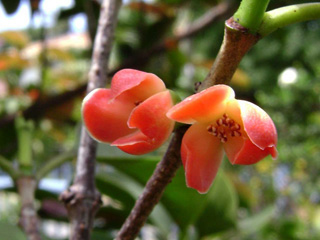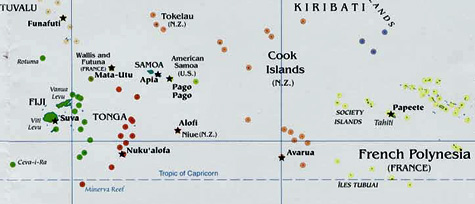Human Flower Project
Tales and Truths of the South Pacific
Wintry where you are? Try basking in floral customs of the Cook Islands, Tonga, Samoa, and Tahiti, courtesy of New Zealander Wendy Cowling.

Heilala (Garcinia sessilis): the national flower of Tonga
Photo: Tauʻolunga, via wiki
By Wendy Cowling
One of the pleasures of spending time with Tongan or Cook Island friends is that when passing a garden or bush plantation/vegetable garden, an islander often will pick some flowers, perhaps hibiscus or gardenia, from bushes lining the path, and distribute these among the members of the group to wear in their hair or to tuck behind an ear. In Tonga it is also common for young men to make wreaths from a grass-like vine that grows on the beaches and wear these wreaths quite unselfconsciously for the rest of the day.
Neck and head garlands of perfumed flowers are the most easily created form of body decoration in contemporary Pacific island communities, as the materials are so readily available. Of course Hawaiians make lei, from the flowers of the frangipani and a wide variety of other brightly colored blooms. Hawaiians pay top dollar for garlands of leaves made from three twined lengths of the sweet-smelling leaved vine, maile (Alyxia oliviformis). These garlands are worn at high school and university graduations and by the brides and grooms at weddings; they’re also used to decorate newly-opened shops. Maile plants, once solely worn by chiefs and sacred hula dancers, seem to have disappeared altogether in Hawai’i, presumably from over-harvesting; nowdays maile is imported from the Cook Islands.

Barack Obama in maile lei, at his high school graduation from Punahou School, Honolulu, Hawaii, 1979
Photo: Rod Lurie, via Politico
In addition to flowers and leaves, the fragrant orange-red, wedge-shaped drupes (fruits) of the Pandanus (Pandanus tectorius – “Screw pine”) are also used to make garlands in Tonga, Samoa and the Cook islands. On public occasions many expatriate Samoans wear facsimiles of the red Pandanus drupe necklaces (once only worn by chiefly males) as an identifier of their ethnicity. The imitations may be made of plastic or of drupes which have been painted bright red.
 Samoan stamp: Ylang-Ylang (Cananga odorata)
Samoan stamp: Ylang-Ylang (Cananga odorata)
Source: Polstamp
The early European visitors to Pacific islands commented on the use of flowers as adornment. The young English sailor William Mariner, stranded in Tonga from 1805 to mid 1811, reported in his memoirs that girls were “… taught to plait various pretty and fanciful devices in flowers which they present to their fathers, brothers and superior chiefs and matapules (chief’s representatives) ….” In Tongan tradition chiefly people were, and are, associated with beautiful perfumes, particularly of the red heilala flower (Garcinia sessilis) Another Pacific island favourite are the green flowers of the tree Cananga odorata, which is known as mokosoi in Fiji, mohokoi in Tonga and moso’oi in Samoa. These flowers are still used by women in island groups such Tonga and Samoa to make coconut oil sweetly fragrant; commercially, Cananga odorata flowers are used to produce the perfume known as ylang-ylang.
Tahitian young men had holes made in their earlobes into which they inserted hibiscus flowers. The missionaries of the London Missionary Society, quick to discern the dangers of sensory distractions, composed edicts in the early years of their work, from the 1820s and on, forbidding the wearing of flowers to church by converts in Tahiti, the Cook Islands and Samoa.

Map of the South Pacific islands
Source: Native Decolonization of the Pacific Rim
Today, while people do not wear flowers on their person when in Protestant churches, the use of flowers (real and artificial) and pot plants to enhance church interiors in contemporary Samoa and the Cook Islands can be quite competitive. In recent years the making of home flower gardens in Samoa has intensified, and people will “borrow” or buy flowers when it is the family’s turn on a church flower roster, to make sure their contribution is pleasing.
In the Cook Islands the rule of not wearing flowers to church was (and is) circumvented by women who, when forced to wear hats in church, made embroidered or woven floral bands to sit between the crown and the brim. The availability of plastic and other artificial flowers has also enabled people living in all Pacific island groups to decorate family graves and their homes with quantities of these, with little concern for contrasts or clashes of colour.
 Schoolgirls in Tonga wore seed necklaces (Pandanus?) and danced for King George Tupou V, who was crowned 8/1/08
Schoolgirls in Tonga wore seed necklaces (Pandanus?) and danced for King George Tupou V, who was crowned 8/1/08
Photo: Torsten Blackwood, for AFP
Many of the islands’ plants and some trees with fragrant flowers were introduced, both by the first settlers of the southern and eastern Pacific (known as the Lapita peoples) and, much later, by Europeans during colonial occupations. During the 19th century plants such as the rose, long grown by European gardeners, were taken to colonial environments and even though they were not really suitable for sub-tropical and tropical climates, they became sources of interest and pleasure to island peoples.
The contents of home gardens in towns and villages in Tonga, the Cook Islands and Samoa, in particular, are now heterogeneous examples of the collecting mania of keen gardeners worldwide. There are island “natives,” other flowering plants and vines that have been legitimately obtained, and still more—smuggled in as cuttings or seeds from other island groups, from South-East Asia, Africa, Australia, South America and the United States.


I knew there had to be a connection between President Obama and flowers! Thank you for the essay Wendy.